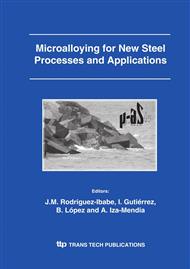p.623
p.631
p.639
p.647
p.655
p.663
p.669
p.677
p.687
Characterization of the Residual Stresses in Plastically Deformed Ferrite-Martensite Steels Using Barkhausen Noise Measurements
Abstract:
In this work, we show that the measurement of the Barkhausen noise allows the residual stresses in each of the two phases of ferrite-martensite steels to be characterized. We have first studied the effect of a tensile and a compressive stress on the Barkhausen noise signature. We observed that for a ferrite-martensite steel, the application of a tensile stress increases the Barkhausen activity of the martensite and ferrite phases, whereas a compressive one reduces it. In a second time, we induced residual stresses by applying a plastic deformation to ferrite-martensite steels. After a tensile plastic deformation, we observed that (i) compressive residual stresses appear in ferrite, and (ii) tensile residual stresses appear in martensite. An opposite behavior is observed after a compressive plastic deformation. These results show that the Barkhausen noise measurement makes it possible to highlight in a nondestructive way the distribution of the stresses in each of the two phases of a ferrite-martensite steel. This result could be used to characterize industrial Dual- Phases steels that are plastically deformed during mechanical processes.
Info:
Periodical:
Pages:
655-662
Citation:
Online since:
November 2005
Authors:
Keywords:
Price:
Сopyright:
© 2005 Trans Tech Publications Ltd. All Rights Reserved
Share:
Citation:


